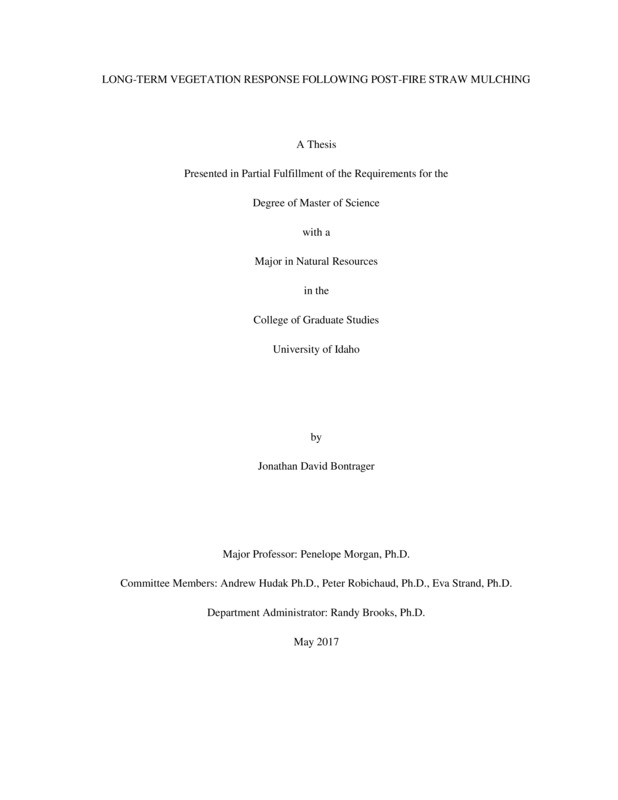LONG-TERM VEGETATION RESPONSE FOLLOWING POST-FIRE STRAW MULCHING
Bontrager, Jonathan D.. (2017). LONG-TERM VEGETATION RESPONSE FOLLOWING POST-FIRE STRAW MULCHING. Theses and Dissertations Collection, University of Idaho Library Digital Collections. https://www.lib.uidaho.edu/digital/etd/items/bontrager_idaho_0089n_11097.html
- Title:
- LONG-TERM VEGETATION RESPONSE FOLLOWING POST-FIRE STRAW MULCHING
- Author:
- Bontrager, Jonathan D.
- Date:
- 2017
- Keywords:
- BAER LandTrendr mulch post-fire recovery
- Program:
- Natural Resources
- Subject Category:
- Natural resource management; Ecology
- Abstract:
-
Although mulching is one of the most common post-fire treatments to reduce soil erosion potential, little is known about the long-term effects (over 10 years) on vegetation response. We assessed the differences in diversity, abundance, cover, tree seedling density, and tree seedling height growth between mulched and unmulched areas on six large forest fires. We chose six fires in the Interior West, spanning two forest types that were mulched between nine and 13 years ago. We collected understory vegetation and tree seedling data, as well as a remotely-sensed change detection algorithm called LandTrendr to assess differences caused by mulching. Mulch did not influence understory plant diversity, species richness, or fractional cover. On mulched plots, tree seedlings grew taller faster, especially on north-facing aspects, and there was 2% more graminoid cover in the vegetation component. While it did not affect density in stems per hectare, it did alter the composition between ponderosa pine and Douglas-fir. Ponderosa pine was favored on northern facing slopes, while Douglas-fir had higher density on southern facing slopes. Our study helps understand long-term vegetation recovery after a severe wildfire, especially how altering immediate post-fire conditions can have lasting effects across the landscape. Managers will be able to assess the long term implications of mulching and better weigh the possible vegetation impact against short-term reductions in soil erosion potential. While there are many concerns about using straw mulch, our study suggests the long-term effects are relatively subtle and do not suggest a change in vegetation trajectories.
- Description:
- masters, M.S., Natural Resources -- University of Idaho - College of Graduate Studies, 2017
- Major Professor:
- Morgan, Penelope
- Committee:
- Hudak, Andrew T; Robichaud, Peter R; Strand, Eva K
- Defense Date:
- 2017
- Identifier:
- Bontrager_idaho_0089N_11097
- Type:
- Text
- Format Original:
- Format:
- application/pdf
- Rights:
- In Copyright - Educational Use Permitted. For more information, please contact University of Idaho Library Special Collections and Archives Department at libspec@uidaho.edu.
- Standardized Rights:
- http://rightsstatements.org/vocab/InC-EDU/1.0/

